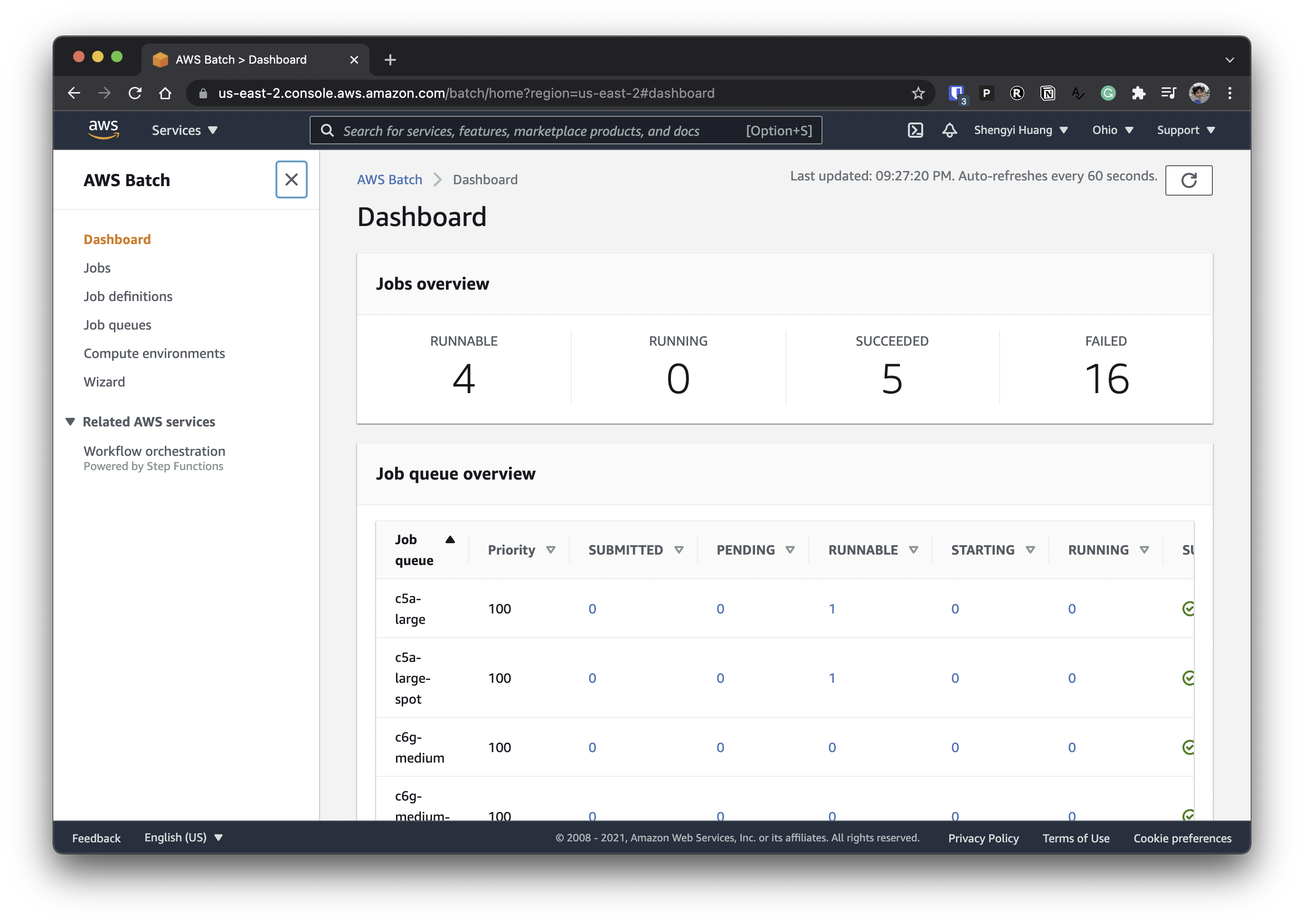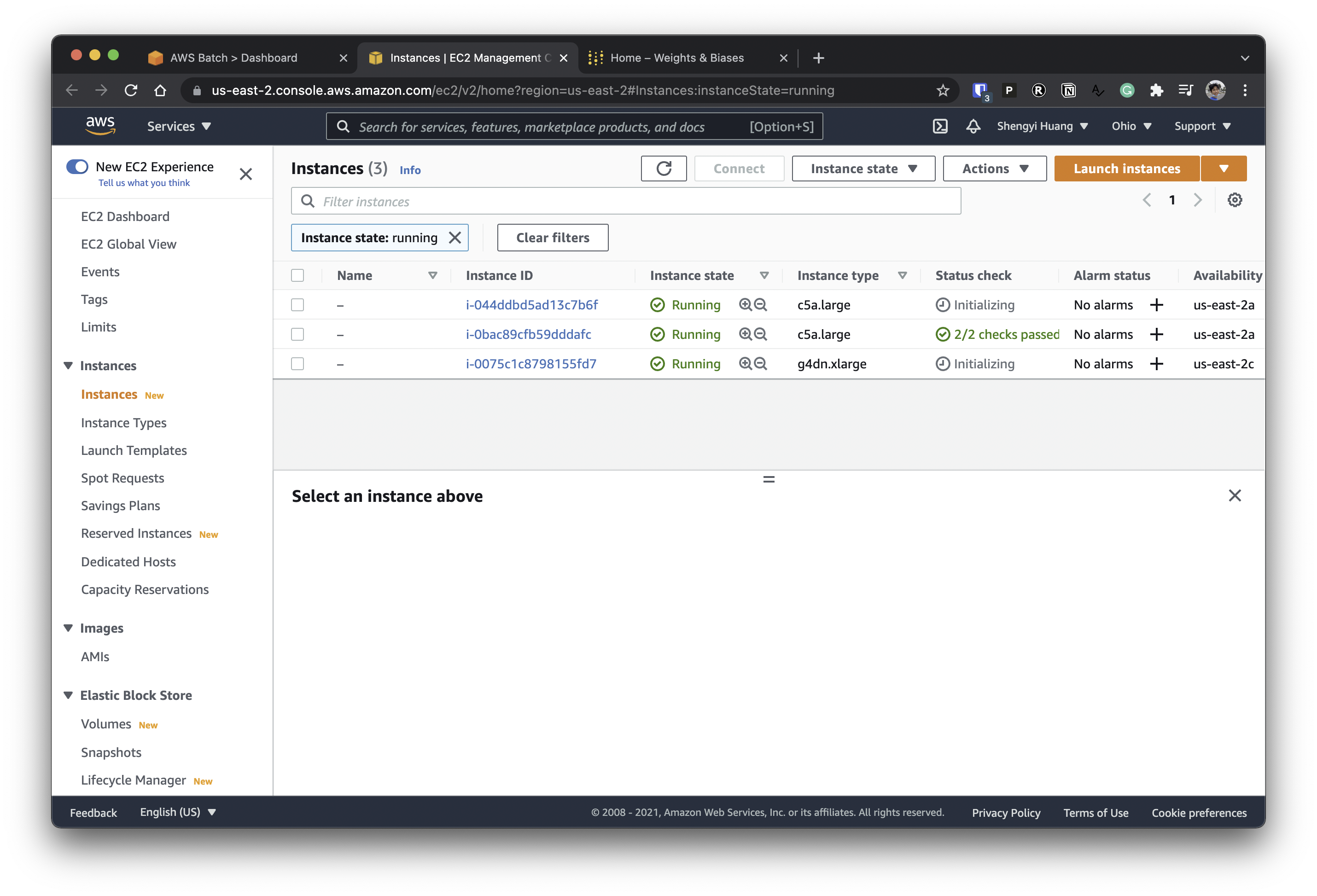Submit Experiments
Inspection
Dry run to inspect the generated docker command
poetry run python -m cleanrl_utils.submit_exp \
--docker-tag vwxyzjn/cleanrl:latest \
--command "poetry run python cleanrl/ppo.py --env-id CartPole-v1 --total-timesteps 100000 --track --capture_video" \
--num-seed 1
The generated docker command should look like
docker run -d --cpuset-cpus="0" -e WANDB_API_KEY=xxxxxxxxxxxxxxxxxxxxxxxxxxxxxxxxxxxxxxxxx vwxyzjn/cleanrl:latest /bin/bash -c "poetry run python cleanrl/ppo.py --env-id CartPole-v1 --total-timesteps 100000 --track --capture_video --seed 1"
Run on AWS
Submit a job using AWS's compute-optimized spot instances
poetry run python -m cleanrl_utils.submit_exp \
--docker-tag vwxyzjn/cleanrl:latest \
--command "poetry run python cleanrl/ppo.py --env-id CartPole-v1 --total-timesteps 100000 --track --capture_video" \
--job-queue c5a-large-spot \
--num-seed 1 \
--num-vcpu 1 \
--num-memory 2000 \
--num-hours 48.0 \
--provider aws
Submit a job using AWS's accelerated-computing spot instances
poetry run python -m cleanrl_utils.submit_exp \
--docker-tag vwxyzjn/cleanrl:latest \
--command "poetry run python cleanrl/ppo_atari.py --env-id BreakoutNoFrameskip-v4 --track --capture_video" \
--job-queue g4dn-xlarge-spot \
--num-seed 1 \
--num-vcpu 1 \
--num-gpu 1 \
--num-memory 4000 \
--num-hours 48.0 \
--provider aws
Submit a job using AWS's compute-optimized on-demand instances
poetry run python -m cleanrl_utils.submit_exp \
--docker-tag vwxyzjn/cleanrl:latest \
--command "poetry run python cleanrl/ppo.py --env-id CartPole-v1 --total-timesteps 100000 --track --capture_video" \
--job-queue c5a-large \
--num-seed 1 \
--num-vcpu 1 \
--num-memory 2000 \
--num-hours 48.0 \
--provider aws
Submit a job using AWS's accelerated-computing on-demand instances
poetry run python -m cleanrl_utils.submit_exp \
--docker-tag vwxyzjn/cleanrl:latest \
--command "poetry run python cleanrl/ppo_atari.py --env-id BreakoutNoFrameskip-v4 --track --capture_video" \
--job-queue g4dn-xlarge \
--num-seed 1 \
--num-vcpu 1 \
--num-gpu 1 \
--num-memory 4000 \
--num-hours 48.0 \
--provider aws
Then you should see:



Customize the Docker Container
Set up docker's buildx and login in to your preferred registry.
docker buildx create --use
docker login
Then you could build a container using the --build flag based on the Dockerfile in the current directory. Also, --push will auto-push to the docker registry.
poetry run python -m cleanrl_utils.submit_exp \
--docker-tag vwxyzjn/cleanrl:latest \
--command "poetry run python cleanrl/ppo.py --env-id CartPole-v1 --total-timesteps 100000 --track --capture_video" \
--build --push
To build a multi-arch image using --archs linux/arm64,linux/amd64:
poetry run python -m cleanrl_utils.submit_exp \
--docker-tag vwxyzjn/cleanrl:latest \
--command "poetry run python cleanrl/ppo.py --env-id CartPole-v1 --total-timesteps 100000 --track --capture_video" \
--archs linux/arm64,linux/amd64
--build --push
Note
Building an multi-arch image is quite slow but will allow you to use ARM instances such as m6gd.medium that is 20-70% cheaper than X86 instances.
However, note there is no cloud providers that give ARM instances with Nvidia's GPU (to my knowledge), so this effort might not be worth it.
If you still wants to pursue multi-arch, you can speed things up by using a native ARM server and connect it to your buildx instance:
docker -H ssh://costa@gpu info
docker buildx create --name remote --use
docker buildx create --name remote --append ssh://costa@gpu
docker buildx inspect --bootstrap
python -m cleanrl_utils.submit_exp -b --archs linux/arm64,linux/amd64